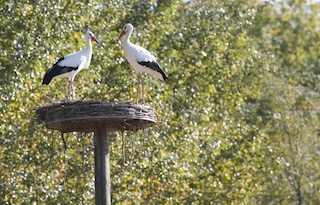The Haute-Garonne and Ariège regions in southwest France are known for their breathtaking landscapes and unspoiled natural environment and have always attracted new arrivals looking for a better quality of life. However, in recent years, the region has also become a popular destination for an even rarer visitor looking to set up home here; storks (cigognes in French).
The storks that have arrived in the Occitanie in recent years are mainly white storks, which are known for their distinctive white plumage and black wing feathers. These birds are migratory and travel to Europe from Africa during the breeding season in search of suitable nesting sites and food sources. In recent years, many storks have diverted from their usual migratory routes and chosen to make the Haute-Garonne and the Ariège their home for the breeding season.
One of the main reasons seems to be the abundance of food sources in the area. The region is home to numerous small mammals, which make up a large part of the stork’s diet. Additionally, the Garonne River and its tributaries provide a plentiful supply of fish, which is another important food source for these birds and the region’s mild climate and large areas of open land make it an ideal site for these birds along with the availability of suitable nesting locations. Storks prefer to nest on tall structures such as chimneys, rooftops, and poles, and the region has plenty of these.
Despite their popularity among birdwatchers and nature enthusiasts, storks have not always been welcome in France. In the past, storks were seen as pests and were hunted for their meat and feathers. However, attitudes towards storks have changed in recent years and most locals generally have a positive view of the storks, seeing them as a symbol of nature and an important part of the region’s heritage. The local authorities have taken steps to protect stork populations, including providing nesting platforms (particularly to encourage them away from tall pylons where there is the danger of electrocution). Many people are also involved in efforts to protect and support stork populations, such as building nesting platforms and monitoring their breeding success.
There are currently estimated to be around 300 stork pairs in the Occitanie region and, as populations in neighboring regions continue to grow, it is likely that stork populations in this region will also increase in the coming years. Indeed, it now appears that some birds seem not to be migrating at all, preferring to stay in the region all year-round – like many of us immigrés who have moved here, they have realized they have found the perfect place to live. Let’s hope that they thrive in the region for years to come.
If you are also looking for your perfect nest in the foothills, please get in touch: nadia@foothillsoffrance.com






You must be logged in to post a comment.